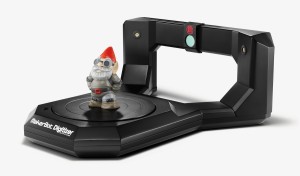Advances in 3D printing and virtual reality beg one question: how do we get all that stuff in there? Obviously, there are creative wunderkind whose artistic and/or coding masterworks can be mistaken for real world objects… but for analysis of real world objects, 3D scanning has come a long way in a very short time.

For smaller objects there are many options, from the ridiculously simple (and low resolution) use of a smartphone camera to specialty devices (like the new MakerBot Digitizer, direct link here) that wistfully remind us of a Star Trek teleporter. For the early adopter or true “maker”, a desktop 3D scanning device could make an indispensable tool — for keeping digital records of a sculptor’s work, creating uniform pieces based off of a single hand-made original and a million other uses.
Ed. Note: How many times did I attempt to hand-carve a collection of identical items for a large-scale architectural model and fail after spending an all-night session working on it? Too many to recall.
But what about 3D scanning of larger objects… something that will not be placed easily and neatly on a turntable? Handheld devices with high resolution are now readily available for use, not just in hi-tech laboratories, but in smaller businesses, medicine, art and even the home.
On a large, more industrial scale, 3D scanning is being used by Hyundai Motor Europe to study automobile seats for new cars and modify them as necessary. Two different scanners from Artec (www.artec3d.com) are used in process: one to create an overall model, scanning from as many angles as necessary to capture the geometry, and a higher resolution device captures the smaller details. All of this data is pulled together in 3D scanning software where the models are virtually assembled and smoothed and, ultimately reviewed or exported to other applications. A four-minute video describing the scanning of the Hyundai car seats is here.
Of course, there is the next logical progression for 3D scanning: the move to the living room. From the same industrial systems that scan Hyundai’s automobile parts for safety, the Artec software system can be combined with the Kinect device that works with Microsoft’s Xbox. Artec Studio for Kinect will let you scan the model, post-process it, fill holes, clean the data, take measurements, export the data and share with your friends and colleagues. The software is not cheap ($649 for a single license of Artec Studio 9.2 — available directly from Artec here), but for the incredible possibilities it could be entirely worth it.
